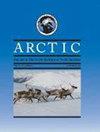交通水平对北极油田产犊驯鹿分布和行为的影响
IF 0.8
4区 地球科学
Q4 ENVIRONMENTAL SCIENCES
引用次数: 0
摘要
驯鹿是阿拉斯加北极地区数量最多的大型陆生哺乳动物,为当地社区提供了重要的文化和生存资源价值。随着石油和天然气开发在阿拉斯加北部北极海岸平原的扩张,了解对驯鹿的潜在影响并改进相关的缓解措施是应用研究的一个关键重点。在阿拉斯加北部持续观察到的一个影响是,在产仔期间和产仔后,母驯鹿在活动油田道路和砾石垫2-5公里范围内流离失所,持续时间为2-3周。解决产仔位移的一个潜在缓解措施是护送交通,以减少产仔区道路上的交通频率和车辆相关干扰。在产仔前、产仔和产仔后的三年时间里,我们对两条油田道路附近的驯鹿进行了频繁的公路和航空调查,一条有护航,另一条没有护航,以评估交通护航的有效性。道路调查表明,离道路较近的驯鹿和有幼崽的群体对交通的反应更频繁、更强,对交通的中等或强烈反应,如站起来步行或逃跑,在有车队的道路附近比在没有限制交通的道路附近更频繁。航测结果表明,有车队的驯鹿群在距离公路至少2公里的地方和有小牛的驯鹿群不车队的情况下在距离公路4公里的地方都有一些避让。即使在对影响分布的其他因素进行调整后,这种关系仍然存在。母驯鹿对道路的回避仅限于产仔期,在产仔前或产仔后时期并不明显。此外,在一年的时间里,产仔场上出现了一个不活跃的高架陆地钻井平台,但在我们的分析范围内,我们没有发现驯鹿在产仔期间避开该结构的证据。本文章由计算机程序翻译,如有差异,请以英文原文为准。
The Effect of Traffic Levels on the Distribution and Behaviour of Calving Caribou in an Arctic Oilfield
Caribou are the most abundant large terrestrial mammals in Arctic Alaska, providing important cultural and subsistence resource values for local communities. As oil and gas development expands across the Arctic Coastal Plain of northern Alaska, understanding the potential impacts on caribou and improving associated mitigation measures are a crucial focus of applied research. One consistently observed impact in northern Alaska is displacement of maternal caribou within 2 – 5 km of active oilfield roads and gravel pads for a period of 2 – 3 weeks during and immediately after calving. A potential mitigation measure to address calving displacement is convoying of traffic to reduce traffic frequency and vehicle-related disturbance on roads in calving areas. We conducted frequent road and aerial surveys of caribou near two oilfield roads, one with convoying and one without, over a 3-year period during the precalving, calving, and postcalving periods to evaluate the effectiveness of traffic convoying. Road surveys indicated that caribou closer to the roads and groups with calves exhibited more frequent and stronger behavioural reactions in response to traffic, and that moderate or strong reactions to traffic, such as standing up and walking or running away, were more frequent near the road with convoying than near the road with unlimited traffic. Aerial survey results indicated some avoidance of areas up to at least 2 km from the road with convoying and 4 km from the road without convoying by caribou groups with calves. This relationship was present even after adjusting for other factors affecting distribution. This avoidance of roads by maternal caribou was limited to the calving period and was not evident during the precalving or postcalving periods. In addition, an inactive elevated terrestrial drilling platform was present on the calving grounds during one year, but we found no evidence of caribou avoidance of that structure during calving at our scale of analysis.
求助全文
通过发布文献求助,成功后即可免费获取论文全文。
去求助
来源期刊

Arctic
地学-环境科学
CiteScore
2.30
自引率
0.00%
发文量
51
审稿时长
6-12 weeks
期刊介绍:
Arctic is a peer-reviewed, primary research journal that publishes the results of scientific research
from all areas of Arctic scholarship. Original scholarly papers in the physical, social, and biological
sciences, humanities, engineering, and technology are included, as are book reviews,
commentaries, letters to the editor, and profiles of significant people, places, or events of northern
interest
 求助内容:
求助内容: 应助结果提醒方式:
应助结果提醒方式:


